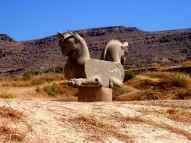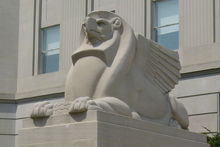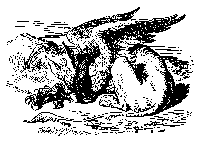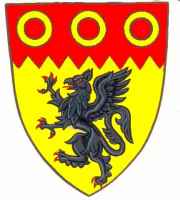Source: http://encyclopedia.thefreedictionary.com/griffin

Composite of Pomeranian heraldic charges of griffin
Nature of griffins

Sassanid Persian silver plate of a Simurgh (Sēnmurw), 4-6th c. A.D

Griffin (Homa) in Persepolis, Iran
Griffins were consecrated to the Sun; and ancient painters represented the chariot of the Sun as drawn by griffins. The griffin was a common feature of "animal style" Scythian gold; it was said to inhabit the Scythia steppes that reached from the modern Ukraine to central Asia; there gold and precious stones were abundant; and when strangers approached to gather the stones, the creatures would leap on them and tear them to pieces. The Scythians used giant petrified bones found in this area as proof of the existence of griffins and to keep outsiders away from the gold and precious stones. It has recently been suggested that these "griffin bones" were actually dinosaur fossils, which are common in this part of the world.

Heraldic guardian griffin at Kasteel de Haar, Netherlands
In Ancient Egypt, the griffin was depicted with a slender, feline body and the head of a falcon. Early statuary depicts them with wings that are horizontal and parallel along the back of the body. During the New Kingdom, depictions of griffins included hunting scenes. Divine figures in egyptian mythology, depicted as griffins, include Sefer, Sefert, and Axex.
Ancient Elamites used griffin symbol extensively in their architecture. In Elam legends, a Griffin was presented to Elamite Gods. In Persian mythology, in particular during the Achaemenid dynasty, griffins called Homa were used widely as statues and symbols in palaces. Homa also had a special place in Persian literature as guardians of light.

A modernist, Egyptianized guardian griffin, Washington D.C.
In architectural decoration the griffin is usually represented as a four-footed beast with wings and the head of a leopard or tiger with horns, or with the head and beak of an eagle. The griffin is the symbol of the Philadelphia Museum of Art and you can see bronze castings of them perched on each corner of the museum's roof, protecting its collection.
A griffin (spelled "gryphon") is featured in Lewis Carroll's Alice in Wonderland in which the Queen of Hearts' orders the gryphon to take Alice to see the Mock Turtle and hear its story. The original illustrations by Sir John Tenniel depict the gryphon in an unusually naturalistic style (pictured to the left).
Some large species of Old World vultures are called gryphons, including the griffon vulture (Gyps fulvus), as are some breeds of dog (griffons).
The scientific species name for the Andean Condor is Vultur gryphus; Latin for "griffin-vulture".
Hippogriffs
Griffins are traditionally regarded as having an antipathy for horses. Therefore the hippogriff, being the offspring of a horse and a griffin, was a doubly impossible being. Nevertheless, some tales depicted their existence.Heraldic griffins
The griffin is often seen as a charge in heraldry.A heraldic griffin (or gryphon) has the hind parts (including legs and tail) of a lion, the upper parts (including feathered neck, wings, claws, and head with beak) of an eagle and also ears. It is the ears which distinguish the griffin's head from an eagle's head in heraldry, which is important because, as well as the full griffin, the griffin's head is also often found in heraldry and would otherwise be identical to the head of the eagle.
According to the Tractatus de armis of John de Bado Aureo (late fourteenth century) “A griffin borne in arms signifies that the first to bear it was a strong pugnacious man in whom were found two distinct natures and qualities, those of the eagle and the lion”. Since the lion and the eagle were both important charges in heraldry, it is perhaps not surprising that their hybrid, the griffin, was also a frequent choice. The symbolism of the lion-eagle combination was also the subject of a quotation attributed to Chassaneus by Alexander Nisbet in his System of Heraldry (1722; p 343 of Vol I of the 1816 edn): "Gryphus significat sapientiam jungendam fortitudini, sed sapientiam debere praeire, fortitudinem sequi.". This translates as: “The griffin represents wisdom joined to fortitude, but wisdom should lead, and fortitude follow". There are alternate translations.
Heraldic griffins are usually shown rearing up, facing left, and standing on one hind leg with the other leg and the claws raised: this posture is described in the Norman-French language of heraldry as "segreant", a word uniquely applied to griffins, and which is the exact equivalent of the description of lions and other creatures in heraldry as "rampant". A heraldic griffin was included as one of the ten Queen's Beasts sculpted for the coronation of Queen Elizabeth II in 1953 (following the model of the King’s Beasts at Hampton Court) and this is now on display at Kew Gardens. The City of London adopted what are usually described as griffins as supporters for its coat of arms, and it marks its boundaries with statues of a single "griffin" carrying the City coat of arms at each road leading into the City of London. However, the City of London griffins are, in fact, heraldic dragons, with scaly bodies and wings, no feathers, and no eagle's beak.
The "keythong"
The heraldic beast called a "keythong" much enjoyed among members of the Society for Creative Anachronism is claimed to appear in a single English manuscript of the reign of Edward IV, a heraldic solipsism. J.R. Planche's Pursuivant of Arms (London 1859) notes, under the badge of the Earl of Ormonde (first creation) as recorded in a College of Arms manuscript under Edward IV, the single contemporary reference: "A pair of keythongs." Planche's footnote: "The word is certainly so written, and I have never seen it elsewhere. The figure resembles the Male Griffin, which has no wings, but rays or spikes of gold proceeding from several parts of his body, and sometimes with two long straight horns. Vade Parker's Glossary, under Griffin." (Society of Creative Anachronism website). At the end of the 20th century the "keythong" began to be taken up enthusiastically among adherents of heraldry.The Griffin Surname
The surname "Griffin" has two primary Gaelic sources in Ireland, which pertain to the towns of Ballygriffey in Co. Clare, and Ballygriffin in Co. Kerry. The spelling "Ó Gríobhtha" is associated with the Co. Clare family, whose surname was also anglicised as "O'Griffey" or "Griffey". "Ó Gríobhtha" translates to English as "decedent of the Griffin-like". The "Ó Griffín" spelling belongs to the Kerry family. In Ireland, the name can also be associated with the Norman surname "Griffith", but to a much lesser degree. (O'Laughin 1997)The surname "Griffin" in Wales is also, generally speaking, a variant of the surname "Griffith", or other similar Welsh names.
Griffins in literature
- Alice in Wonderland by Lewis Carroll (see reference in summary above)
- In Neil Gaiman's Sandman comic book series, a griffin is one of three guardians of Morpheus' palace in The Dreaming
- Griffin is the Invisible Man in H.G. Wells' novel The Invisible Man.
- Griffin is Monster in My Pocket #5.
- The Crossroads series by Nick O'Donohoe, including The Magic and the Healing, Under the Healing Sign, and Healing of Crossroads. Griffins play a significant role in this series about veterinary students called upon to help mythological creatures.
- Three varieties of griffins, with different spellings and very different dispositions, appear in the popular children's novel David and the Phoenix by Edward Ormondroyd.
- Griffins are among the magical creatures that exist in the Harry Potter series. Harry Potter's house (i.e., grouping of pupils) at Hogwarts School of Witchcraft and Wizardry is called Gryffindor, after its founder Godric Gryffindor. "Gryffindor" may come from the French "gryffon d'or" or "golden griffin", but, oddly, its emblem is a lion and not a griffin. The gargoyle guarding the Hogwarts headmaster's office is depicted in the Harry Potter movies as a half-phoenix, half-lion griffin.

Cover of The Griffin and the Minor Canon drawn by Maurice Sendak, re-issued by HarperCollins.
- The Griffin and the Minor Canon by Frank R. Stockton, illustrated by Maurice Sendak (1968)
- Collinsfort Village by Joe Ekaitis, illustrated by Nick Greenwood, features a griffin living near an imaginary Colorado suburb.
- Gryphons are among the creatures in Aslan's army in The Chronicles of Narnia.
- The Mage Wars Trilogy by Mercedes Lackey and Larry Dixon. A gryphon known as Skandranon is one of the lead characters. Titles are The Black Gryphon, The White Gryphon and The Silver Gryphon.
- The Divine Comedy by Dante Alighieri. A griffin pulls the chariot which brings Beatrice to Dante in Canto XXIX of the Purgatory.
- Revenge of the Shadow King by Derek Benz and J.S. Lewis
- A human baby turns into a griffin in Wilanne Schneider Belden's Frankie!
- Griffins play a part in the Dragonlance novels, under the command of Elves.
- In the Eberron campaign setting for Dungeons & Dragons, the griffon is the heraldic beast of the dragonmarked House Jorasco.
- In The Once and Future King by T. H. White, young Arthur and his step-brother Kay battle a fierce griffin with aid from Robin Hood soon after freeing captives of Morgan le Fay.
- In Baldur's Gate 2, the gnome NPC Jan Janssen's family (according to him) has had a number of encounters with griffins, mostly as a food source. One spoken line from the character is a panicked "What? Is there a griffin about?"
- There is a Griffin-like, English gargoyle, in the animated series Gargoyles, named Griff.
- In the Warcraft Universe, Griffons serve as flying mounts to Dwarves and other races of the Alliance.
Other
- Midland Bank used a griffin as its symbol before it was subsumed into its HSBC parent company.
- Waterloo Rugby Club's badge features a griffin in the centre of a red Lancastrian Rose.
- Balshaws High School logo features a griffin in the centre as well as the words Non Sibi Sed Alis.
- Griffin is a somewhat rare boy's name from the 1990s.
- The Norwegian county of Troms and municipality of Bjarkøy have griffons in their coat-of-arms.
- De Montfort University uses a griffin for its logo.
- Vauxhall Motors of Luton, England, uses the griffin as its trademark.

- Saab Automobile AB also uses the Griffin as its Logo. Saab Aerospace built a fighter jet, the JA-39 Gripen, which in Swedish means "Griffin".
- Chestnut Hill College in Philadelphia, PA uses the griffin as its mascot and its symbol.
- Missouri Western State University in St. Joseph, MO uses the griffin as its mascot.
Spelling variants
Griffin has been spelled various ways: gryphon, griff, griffen, griffon, griffoun, griffun, griffyn, grifo, grifon, grifyn, grefyne, gríobhán, griphin, griphon, gryffen, gryffin, gryffon, gryfon, gryf, gryphen, and gryphin.References
- O'Laughin, M. C. (1997). "The Book of Irish Families Great & Small". Irish Genealogical Foundation.
See also
- Griffin (surname)
- Busch Gardens Europe in Williamsburg, VA has announced their new rollercoaster for 2007 will be Griffon, designed by Swiss manufacturer Bolliger & Mabillard.
- Simurgh
- Homa
- The home ground of english football team Brentford FC is called Griffin Park because of the Griffin that features in the logo of Fuller's Brewery, which had previously owned the land. A local pub next to the ground is also named 'The Griffin'.
- JAS-39 Gripen, a fighter aircraft built by Saab
- Pomfret School in Pomfret, Connecticut; whose mascot is the griffin
- Lincoln-Way East High School in Frankfort, IL; whose mascot is the griffin
- Canisius College in Buffalo, New York; whose mascot is the griffin
- Chestnut Hill College in Philadelphia, Pennsylvania; whose mascot is the griffin
- Reed College in Portland, Oregon; whose mascot is the griffin
- Sarah Lawrence College in Bronxville, New York; whose mascot is the gryphon
- Grand Rapids Griffins, a team in the American Hockey League
- St. George's Independent School in Collierville, TN. Whose mascot is the gryphon.
- Lehigh University, whose Gryphon Society are the mentors to the Freshmen Class.
- Los Alamitos High School
- London Griffins; a rugby league club whose mascot is the griffin.
- Guelph Gryphons; the University of Guelph, Guelph, Ontario, Canada whose mascot is the gryphon.
- Kathy Griffin An American stand-up comedian and actress.
External links
- The Gryphon Pages, a repository of griffin lore and information
- Griffins in Art and on the Web, an "art history through griffins"
- Greek Mythology Link Bestiary: Griffin, quoting Herodotus, Pausanias, Strabo
- Fossil Hunters: Paleontology in Greek and Roman Times
- Lady Gryphon's Mythical Realm: Griffin Aerie
- Beasts of Ancient Egypt
- Gryphons on



















No comments:
Post a Comment